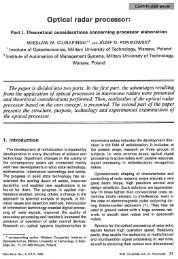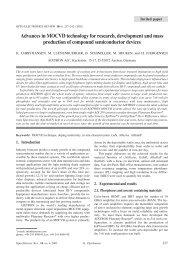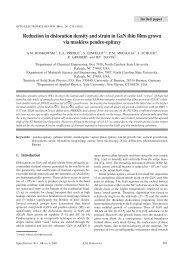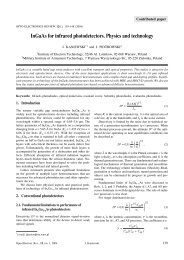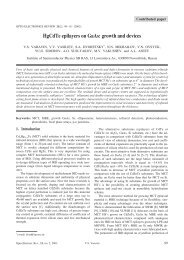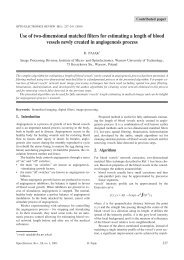<strong>Antiferroelectric</strong> <strong>liquid</strong> <strong>crystal</strong> <strong>displays</strong>Fig. 2. Electrooptical responses of two ferroelectric families showing analogue greyscale: left, V-shape smectic; right, tristateantiferroelectric LC.Switching time is another essential feature for any LCmaterial to be used in high-end <strong>displays</strong>. Switching timesof all kinds of surface-stabilized FLCs are significantlylower (5–50 µs typically) than nematic switching times.The V-shape and tristate AFLC cases are less straightforward.Indeed, their switching times are similar to otherFLC families (regular FLCs, for example). However,achieving the 0-volt state requires the absence of externalvoltage. This relaxation process is significantly slower thanswitching. To overcome this problem, the driving waveformmust include voltage signals performing forced relaxationsof switched materials.2.3. Contrast in V-shape and AFLC <strong>displays</strong>: thepretransitional effectContrast in V-shape smectics is excellent too (> 100:1), asin regular FLC <strong>displays</strong>. However, contrast in tristableAFLC <strong>displays</strong> is only fair (30:1–40:1 typically). The contrastratio is impaired by light leakage in the dark state.This is in turn attributed to a phenomenon calledpretransitional effect (PE, Ref. 15). The most noticeableconsequence of PE is that the dark state transmission obtainedin the AFLC ® FLC voltage-induced phase transitionis higher than the transmission at zero voltage as longas a bias voltage for grey level stabilization is employed.Although this leakage does not invalidate the tristable approach,it certainly limits its use in applications demandinghigh contrast. Two different solutions have been proposedto circumvent the problem: either using V-shape materialsshowing thresholdless switching or using orthoconicantiferroelectrics.The first solution is equivalent, in practice, to an enhancementof PE; this enhancement, nevertheless, is usedto generate the greyscale itself. V-shape smectics were formerlyknown as thresholdless antiferroelectrics [16]. Althoughmuch work has been done to demonstrate thatV-shape materials cannot be ultimately considered regularAFLCs [17,18], the fact is that V-shape responses arefound in AFLC materials when external parameters such asmanufacturing conditions, frequency, and temperature aremodified. Anyhow, the lack of hysteresis precludes passivemultiplexing of V-shape smectics; as mentioned above,V-shape multiplexing requires an active matrix to addressthe display.The second solution takes advantage of the excellentdark state shown by orthoconic materials. Passive and activemultiplexings are possible, and waveforms are substantiallythe same as in regular antiferroelectric <strong>displays</strong>[19].3. Multiplexing V-shape and antiferroelectric<strong>displays</strong>3.1. Analogue greyscale in AFLC <strong>displays</strong>The intrinsic bistability of regular FLC <strong>displays</strong> is a clearadvantage for multiplex driving, but precludes the generationof grey levels. These are necessary to produce a fullcolour gamut, a must in high-end <strong>displays</strong>. Besides their arguabledisplay quality, AFLCs show intrinsic analoguegreyscale. This is one of the main advantages of these materials.The greyscale generation is compatible with passivemultiplexed addressing. The use of an analogue greyscale,in principle, enhances the display performance as comparedto dithering techniques. Moreover, the data rate issubstantially reduced: the data rate of the display mentionedabove would be brought from 2 Gbps down to250 Mbps if analogue greys are used. Actual data rates dependon whether and how AD/DA converters are employedin driving electronics. The use of AD/DA conversion notwithstanding,the required rate of analogue data pulses fordisplay columns is reduced down to the above mentionedfigure.266 Opto-Electron. Rev., 12, no. 3, 2004 © 2004 COSiW SEP, Warsaw
XV Liquid Crystal ConferenceFig. 3. Addressing waveforms for passive AFLC multiplexing. 1 – Simplest selection-bias waveform. 2 – Same as previous, including areset time to allow the material to relax between frames. 3 – Waveform proposed by our group. It includes a well pulse (c) to force therelaxation. 4 – Waveform proposed by Okada group based on blanking through saturation.Figure 3 shows several passive addressing schemes forAFLC multiplex driving. The hysteresis cycle is presentedfor reference, while time axis increases downwards. Waveform3.1 is a simple selection-bias scheme. Grey levels areselected (a, c) and eventually stabilized by bias pulses (b,d) along the frametime. Selection is performed throughAFLC ® FLC voltage-induced phase transition. Thisscheme, however, shows memory effect, i.e., the grey levelachieved in one frame depends on the grey level of the previousframe. To avoid memory effect, the pixel must beerased between consecutive frames. Waveform 3.2 includesa reset time (c) to allow relaxation of the pixelthrough an FLC ® AFLC mechanism in the absence of appliedvoltage. This waveform can be used for low rate applications;however, it is not satisfactory for applicationsrequiring high frame rates (e.g., video) ca. room temperature,since reset time must be extended several ms to allowfull relaxation of the AFLC material. This problem can becircumvented by forcing the relaxation with a counter-pulse(well pulse) previous to reset time. The resultingwaveform [20], proposed by our group, is shown in section3.3. An alternative waveform, shown in section 3.4, wasproposed by Okada et al. [21]. It is based on interframe saturation(a, d) of the pixels. This addressing scheme is fasterthan the previous ones, as it does not include any slow relaxationstep. However, the achieved greyscale is less satisfactory.Other waveforms have been recently proposed [22] tospeed up further the AFLC response. This is specially importantin orthoconic AFLC materials. The electrooptic behaviourof these materials is similar to the behaviour of anyother AFLC, in particular, they can be addressed with thesame driving schemes as regular AFLC materials.Orthoconics have been extensively studied in the last fewyears [23] to improve performance of AFLC <strong>displays</strong> takingadvantage of their far superior contrast ratio. However,actual orthoconic materials usually show poor dynamic response.New waveforms allowing passive multiplexing oforthoconic <strong>displays</strong> at video rate are presently being developed.Shortly after the advent of antiferroelectric materials, anumber of prototypes were built. Nippondenso [24] developeda video-rate, full colour, 6” display for car navigationsystems and a 17” full colour flat panel display for desktops, while Citizen [25] showed a monochrome VGA 5.5”prototype. None of these became a commercial realization,mostly due to the poor contrast exhibited by regularAFLCs. Once orthoconic materials are available, it is expectedthat a renewed interest on development of passiveAFLC <strong>displays</strong> will arise. At present, a helmet-mounteddisplay prototype for enhanced reality and external data supervisionis being developed for firefighters [26].3.2. Analogue greyscale in V-shape smectic <strong>displays</strong>V-shape smectics do not show hysteresis; any positive ornegative voltage applied to a V-shape cell produces a transmissionvariation. Saturation is usually achieved in lessthan 5 volts. This thresholdless IPS switching arises thepossibility of using V-shape materials as an alternative tostandard nematics in high-end applications on active matrices.Indeed, their ferroelectric nature gives them an excellentdynamic response whereas their IPS switching yields awide viewing angle. Several direct-view display prototypeshave been presented [27,28], however, no commercialproducts have been presented yet, mostly due to the lack ofsuitable materials showing long-term electrical and chemicalstability. Nematic <strong>displays</strong>, in the meantime, have remarkablyreduced the advantage in dynamics and viewingangle.Other possibilities for V-shape materials have been explored.Specifically, their use in photonic devices such asspatial light modulators (SLM) [29] has been proposed.V-shape micro<strong>displays</strong> have also been proposed for projectionapplications [30]. In both cases, the devices employ<strong>liquid</strong> <strong>crystal</strong> on silicon (LCOS) active matrices, as opposedto TFT matrices. LCOS matrices are prepared instandard silicon wafers, and metallized to work in a reflectivemode. V-shape LCOS devices can work over 250 Hz,i.e., four times the 60-Hz video frequency. As a conse-Opto-Electron. Rev., 12, no. 3, 2004 J.M. Otón 267



